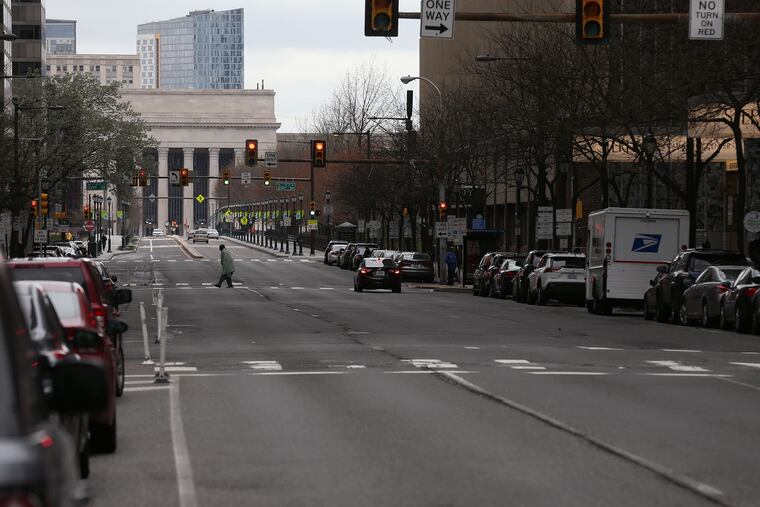Cell phone records show dramatic drop in regional travel outside Philly after governor’s COVID-19 order
Experts offered possible explanations for why Philadelphians are moving more than those in the suburbs, ranging from its poverty level to merely having a larger population. The city also has more hourly workers, such as grocery store clerks who have to be at work.

On the evening of March 19, as Pennsylvanians got home from work and turned on their TVs, Gov. Tom Wolf said he would shut down all businesses that weren’t “life-sustaining," taking his most drastic step yet to slow the spread of the coronavirus.
It appears Pennsylvanians were listening.
During the next two days, residents across the state drastically cut down their daily travel, according to an Inquirer analysis of cell phone data. And almost all of the commonwealth’s counties saw their biggest drops in movement on March 21, including Philadelphia, where travel plummeted nearly 66% from the day before.
In the days since, travel in the Philadelphia region has nearly come to a halt, though city residents have remained somewhat more mobile than their suburban and South Jersey counterparts.
The data, provided by New York location intelligence firm Cuebiq, put some hard numbers to the deserted streets and empty offices throughout Pennsylvania. The most clear-cut finding: March 21 was the day when the majority of the state’s residents most dramatically cut the distance they traveled per day. Sixty of the state’s 67 counties saw their steepest drops in daily movement that day.
The data is based on the Cuebiq Mobility Index, which is a scale of 0-5. Higher numbers mean people are moving around more, and using a scale allows counties to be compared against one another even if they travel different distances on a normal day.
According to the data, the index in Philadelphia fell by 1.81 in a single day, from 2.75 on March 20 to 0.94 on March 21. During the same period, Bucks County fell by 1.5 and Delaware County fell by 1.4.
However, travel in two suburban counties had dropped off before Wolf’s order. Montgomery and Chester Counties both saw their steepest declines on March 19, when the index in Chester County dropped by 1.2 and in Montgomery County it dropped by almost 1. Both continued to drop after the order as well. The other five counties saw their biggest drop after March 21.
Montgomery and Chester Counties are among the wealthiest in the state, and were some of the first to see restrictions on restaurants and closure of non-essential retailers. In addition to being the first to decrease travel, their residents also traveled the lowest distances overall, the data show. They share the largest regional percentage drop in their mobility score, calculated as a week-over-week change between the first week of March and last week, ending April 5.
Meanwhile, Philadelphians, who are more likely to be poorer or essential workers. have moved around more than people in the surrounding suburbs.
Locally, Montgomery County residents traveled 67% less from the first week of March to the week ending April 5. Movement fell 65% in Chester County, 59% in Bucks County, and 58.5% in Delaware County. Philadelphia’s mobility dropped 44% during the same period.
In New Jersey, Burlington County and Gloucester County residents cut their travel by 57% and 51% respectively. Camden County’s mobility score fell 46%. New Castle County in Delaware slashed travel by nearly 48%.
Experts offered several possible explanations for why Philadelphians are moving about more than people in the suburbs, ranging from its high level of poverty to its merely having a larger population. The city also had more hourly workers, such as grocery store clerks and delivery drivers, many of whom have been deemed essential employees and are still working to make a living.
In fact, a statewide comparison between the change in mobility and per-capita income by county shows that there is a direct relationship between higher income and a larger drop in movement.
“There’s no secret there, that people who are living out in the suburbs have higher incomes and are more likely to be salaried, so we’re not affected by a loss of hours here and there," said Mariana Chilton, a public health professor at Drexel University. "Whereas those who are hourly workers, who have no health insurance and don’t have a lot of job control, are having to stay on the move, having to get to work, having to take public transportation.”
The data from Cuebiq, a location-intelligence company, help shops measure whether advertisements drive sales. The firm tracks people on their smartphones if they opt in to location data services, allowing Cuebiq to measure how far Americans travel each day.
The mobility score for each county is the median of those per-person distances. Although not everyone has opted in, millions of people permit tracking of their movements, enough to be statistically representative.
“Users also have the option to opt out of this at any time should they change their mind. The data collected contains no personally identifiable information and is anonymized to look at macro-level trends,” Sara Hollabaugh of Daddi Brand Communication said on behalf of Cuebiq.
Cuebiq is one of many companies sharing their cell-phone tracking data to show how well people are staying home during the pandemic. The company with the most common household name is Google, which released reports on mobility on March 29. Google collects data from users of its Android mobile phone operating system.
Though the approaches differ, all the different location data that has been released has shown a comparable drop in travel.